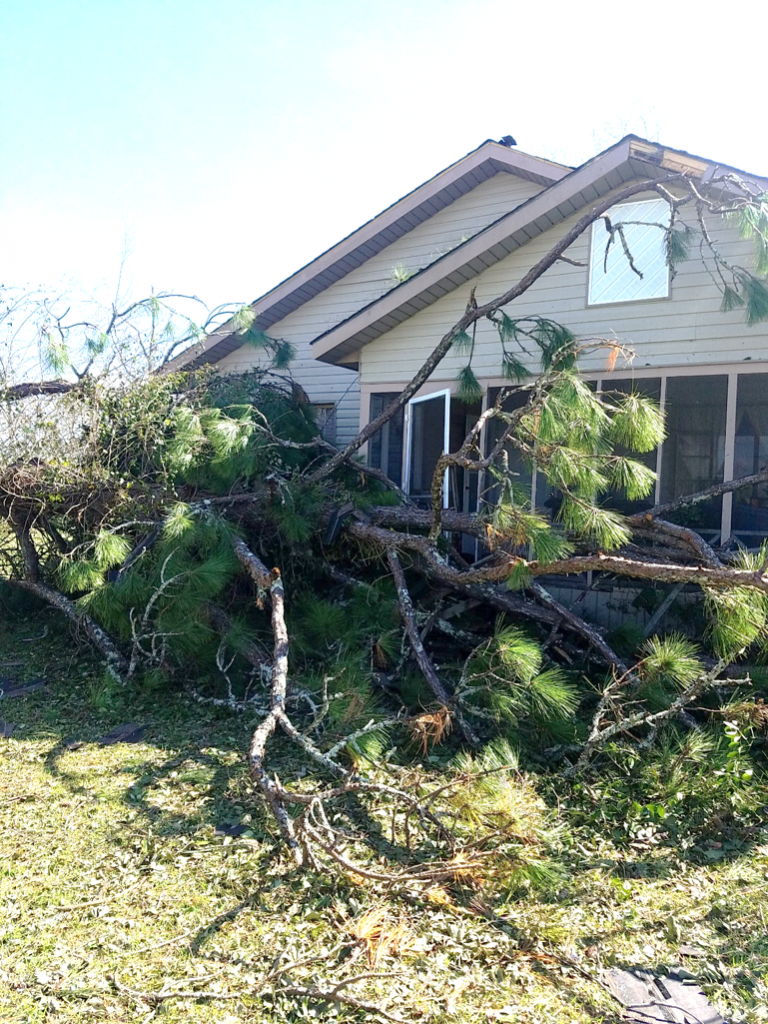
Structural damage to homes, barns, sheds, etc. is oftentimes hidden from view. Thorough inspections for seen and unseen structural damage is a critical step in the rebuilding process. Photo by Judy Biss
The United States has suffered a series of devastating natural disasters in a relatively short time: September’s Hurricane Florence in North Carolina, October’s Hurricane Michael in Panhandle Florida, November’s Camp Fires in California, and most recently, the November 30th earthquake in Alaska. For those rebuilding after disasters, a critical step is determining the extent of structural damage that may have occurred because of high winds, floods, or seismic quakes. As we continue our rebuilding efforts in North Florida, it is important to understand what to look for while assessing building damage. Often the damage is hidden within the structure, and not immediately obvious.
In response to requests from the Alaska Extension network after the November earthquakes, Dr. Kenneth Hellevang, North Dakota State University Extension Engineer, Professor, and Fellow-American Society of Agricultural and Biological Engineers, provided the information below on how homeowners can conduct their own initial damage assessments to determine building soundness and safety after a disaster. Although written for flooded homes, many of these guidelines apply to hurricane-damaged homes as well.
******************************************************************************************
North Dakota State University, After the Flood, News Releases: Check Buildings’ Structural Soundness
Kenneth Hellevang, Ph.D., PE, Extension Engineer, Professor, Fellow-American Society of Agricultural and Biological Engineers
Before attempting to restore buildings, evaluate the extent of damage and amount of repairs necessary.
“The first thing to do with a building is to check its structural soundness,” says Ken Hellevang, North Dakota State University agricultural engineer. “If the building has been moved, shifted or twisted, it may not be safe to enter. Also, while damage is obvious in many cases, it may not be noticeable immediately and could weaken the building or cause other problems.”
If the building has extensive damage, tearing it down and rebuilding probably will be less expensive than trying to repair it. As a rule of thumb, if repairs and restoration cost more than 60 percent of rebuilding, building a new structure generally is the best option.
To do a thorough inspection, check:
- Ridge and eaves to make sure they are straight
- Walls to see if they still are vertical and straight
- The building to see if has shifted on its foundation
- Frame members, such as knee braces, to see whether they’ve been pushed into the siding or up into the roof
- Trusses and rafters for signs of crushed, split or broken wood
- Frame members to make sure they haven’t buckled or twisted, aren’t bowing out of alignment and don’t appear to have slipped relative to each other or have gaps in a truss joint
- Connections for indications that nail, screw or bolt holes are elongated and nails or other connectors are pulled out of the wood or bent
- Pole building posts for crushed or broken wood near the ground or at truss connections or knee braces. Make sure the posts are straight and vertical. Look for indications that posts made of more than one board may have split along rows of nails.
- Doors or windows to make sure they open as they did before. If they do not, this may indicate the structure has shifted. In cases of severe shifting, water lines, gas lines and electrical circuits may have been damaged.
- Electrical circuits for damage
- Siding and metal roofing for tears around fasteners, evidence of fasteners being pulled, bends or buckles in the metal roof sheets and whether the sheets still are aligned with each other
- Wood for indications of damage that could weaken the building.
You should document any damage with photos and contact your insurance company. Also, consult with a building contractor or engineer if you see several indications of damage.
NDSU Extension specialists Carl Pedersen and Ken Hellevang review what to look for as you re-enter a flooded home in the following videos:
Flooded Home: Inspecting the Outside of the Structure
Flooded Home: Entering the Home the First Time
Flooded Home: Electrical Issues
Flooded Home: Checking Out the Mechanical Systems
________________________________________________________
Kenneth Hellevang, Ph.D., PE, Extension Engineer, Professor
Fellow-American Society of Agricultural and Biological Engineers
Agricultural & Biosystems Engineering Department, North Dakota State University Extension Office:
ABEN 117 NDSU Dept 7620, P.O. Box 6050, Fargo, ND 58108-6050
E Mail: Kenneth.Hellevang@ndsu.edu
http://www.ag.ndsu.edu/extension-aben
- November 2025 Weather Summary & Winter Outlook - December 5, 2025
- Friday Feature: The History of Beekeeping - December 5, 2025
- Friday Feature:Malone Pecan Festival Tractorcade - November 21, 2025
